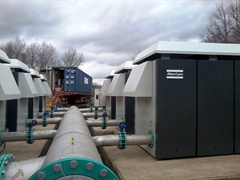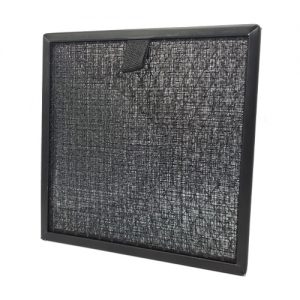 Anglian Water, one of the UK’s largest water and wastewater treatment companies – operating over 1000 wastewater treatment works in the East of England – uses Atlas Copco’s low-pressure ZS blowers to supply air to the aeration diffusers at four of its wastewater treatment re-development site. A total of 22 blowers have been installed at the sites in Colchester, Letchworth, Bedford and Flag Fen, near Peterborough as part of Anglian Water’s initiative to find innovative ways of reducing its energy costs.
Anglian Water, one of the UK’s largest water and wastewater treatment companies – operating over 1000 wastewater treatment works in the East of England – uses Atlas Copco’s low-pressure ZS blowers to supply air to the aeration diffusers at four of its wastewater treatment re-development site. A total of 22 blowers have been installed at the sites in Colchester, Letchworth, Bedford and Flag Fen, near Peterborough as part of Anglian Water’s initiative to find innovative ways of reducing its energy costs.
Wastewater treatment plants use bacteria to break up waste which requires large quantities of air to be blown into aeration tanks. In a typical biological wastewater treatment plant, the blower system will account for up to 70% of energy usage. Anglian Water used Hydrok, an aeration diffuser and IFAS specialist, to provide submerged, high-efficiency, bubble aeration framework systems incorporating bio textile curtains and fixed bed media. These units improve the distribution of aeration air to maintain the desired level of dissolved oxygen within the wastewater containment system. The Hydrok high efficiency technology was matched with Atlas Copco ZS low pressure screw blowers, which make energy cost savings of up to 35% possible, for optimum performance.
Protect The Air Intake
 Following installation and commissioning the blowers were affected by the local environment which contained high levels of insects, dust and pollen. This airborne debris was being sucked into the oil cooling coils which decreased heat dissipation and increased energy running cost. Designed with a weather panel inlet cowl to protect the air intake from water, the cowl faces downward so that it is less likely to have rain running across the opening or being sucked in. While protected from rain, the inlets were not protected from ground-level particulate contamination. When a coil becomes fouled with dirt and grime, it cannot provide adequate heat transfer. The equipment compressor senses this, and tries to overcome it by going to a higher system pressure, consuming a greater level of electricity.
Following installation and commissioning the blowers were affected by the local environment which contained high levels of insects, dust and pollen. This airborne debris was being sucked into the oil cooling coils which decreased heat dissipation and increased energy running cost. Designed with a weather panel inlet cowl to protect the air intake from water, the cowl faces downward so that it is less likely to have rain running across the opening or being sucked in. While protected from rain, the inlets were not protected from ground-level particulate contamination. When a coil becomes fouled with dirt and grime, it cannot provide adequate heat transfer. The equipment compressor senses this, and tries to overcome it by going to a higher system pressure, consuming a greater level of electricity.
Rob Boughton, Atlas Copco Low-Pressure Sales Manager, contacted Richard Betts of RAB Specialist Engineers Limited for assistance with what had the potential to be a severe problem. Six weekly maintenance visits were required to keep the coils clean, typically costing around £350.00 ($588 US) per visit. However, even with these regular visits, the coils remained clogged with airborne debris during the intervening weeks.
Permanent Electrostatic Filters
 After discussions regarding the air intake process, the weatherproof cowling was identified as the best location for an external permanent electrostatic filters. The filter had to be easy to affix and remove, easy to clean, have minimal effect on airflow, and capture a high level of airborne debris. RAB Specialist Engineers and Atlas Copco selected Permatron’s PreVent® Model R filter screen for the job. Black honeycomb (BHC) polypropylene media was fitted to a rigid steel frame complete with a magnetic strip for easy installation, and cloth pull tabs on the short sides to enable easy removal. Manufactured to the exact size of the air intake opening the finished product took less than 15 minutes to install. Insects, seeds, feathers, pollen, and dust are all captured by this external filter which, because of its unique magnetic framework, can be easily removed and cleaned to maintain airflow (initial resistance 1.25pa or 0.02 in. @ 0.5m/s) to the cooler. Six months later, Rob Boughton advised that the air intake screens have stopped the contamination of the oil coolers thus allowing the original energy saving criteria to be maximized.
After discussions regarding the air intake process, the weatherproof cowling was identified as the best location for an external permanent electrostatic filters. The filter had to be easy to affix and remove, easy to clean, have minimal effect on airflow, and capture a high level of airborne debris. RAB Specialist Engineers and Atlas Copco selected Permatron’s PreVent® Model R filter screen for the job. Black honeycomb (BHC) polypropylene media was fitted to a rigid steel frame complete with a magnetic strip for easy installation, and cloth pull tabs on the short sides to enable easy removal. Manufactured to the exact size of the air intake opening the finished product took less than 15 minutes to install. Insects, seeds, feathers, pollen, and dust are all captured by this external filter which, because of its unique magnetic framework, can be easily removed and cleaned to maintain airflow (initial resistance 1.25pa or 0.02 in. @ 0.5m/s) to the cooler. Six months later, Rob Boughton advised that the air intake screens have stopped the contamination of the oil coolers thus allowing the original energy saving criteria to be maximized.

